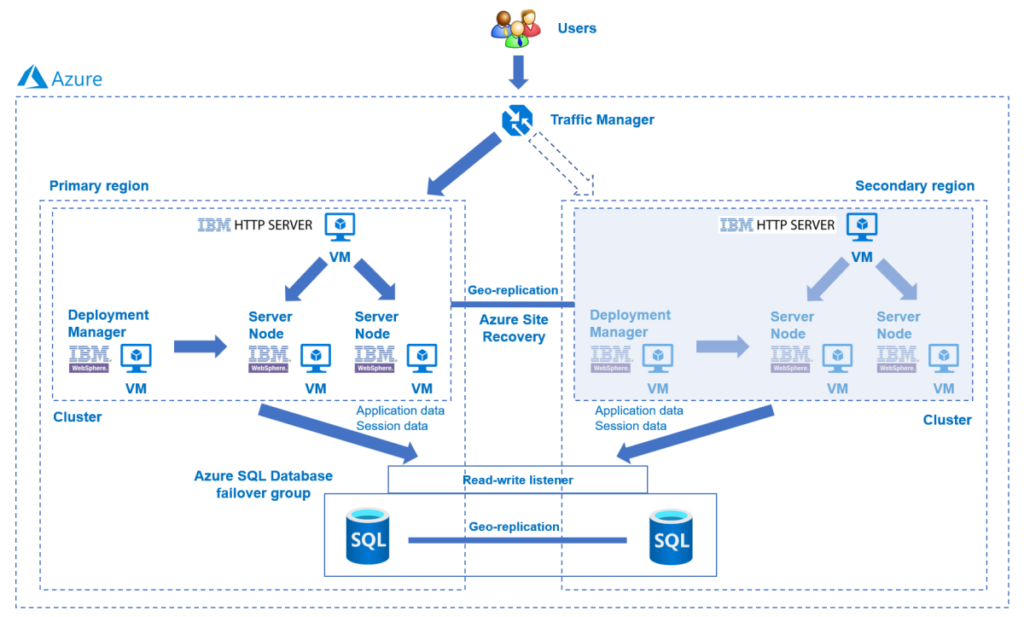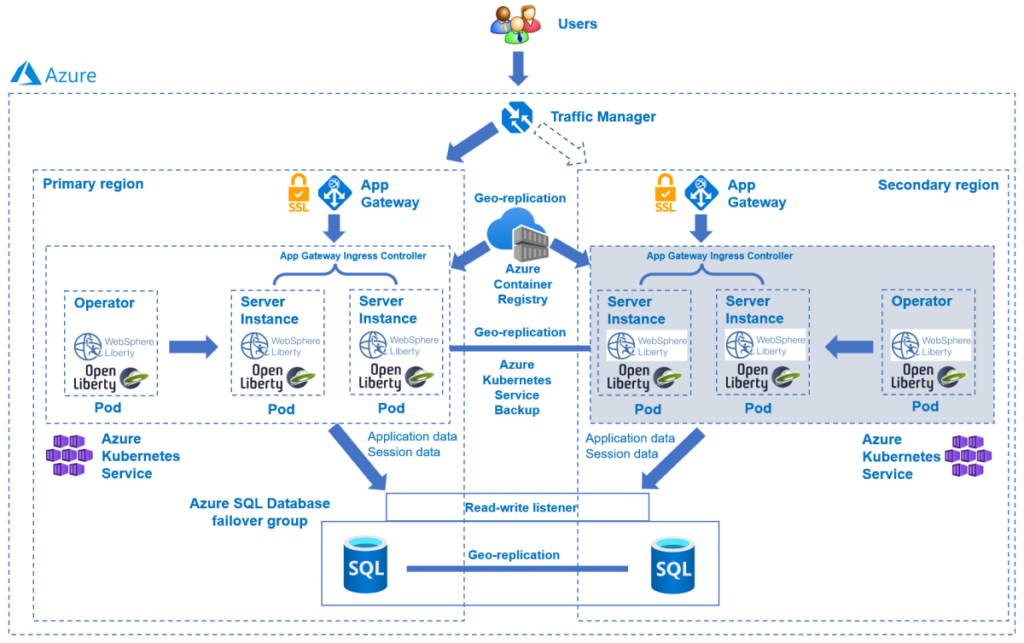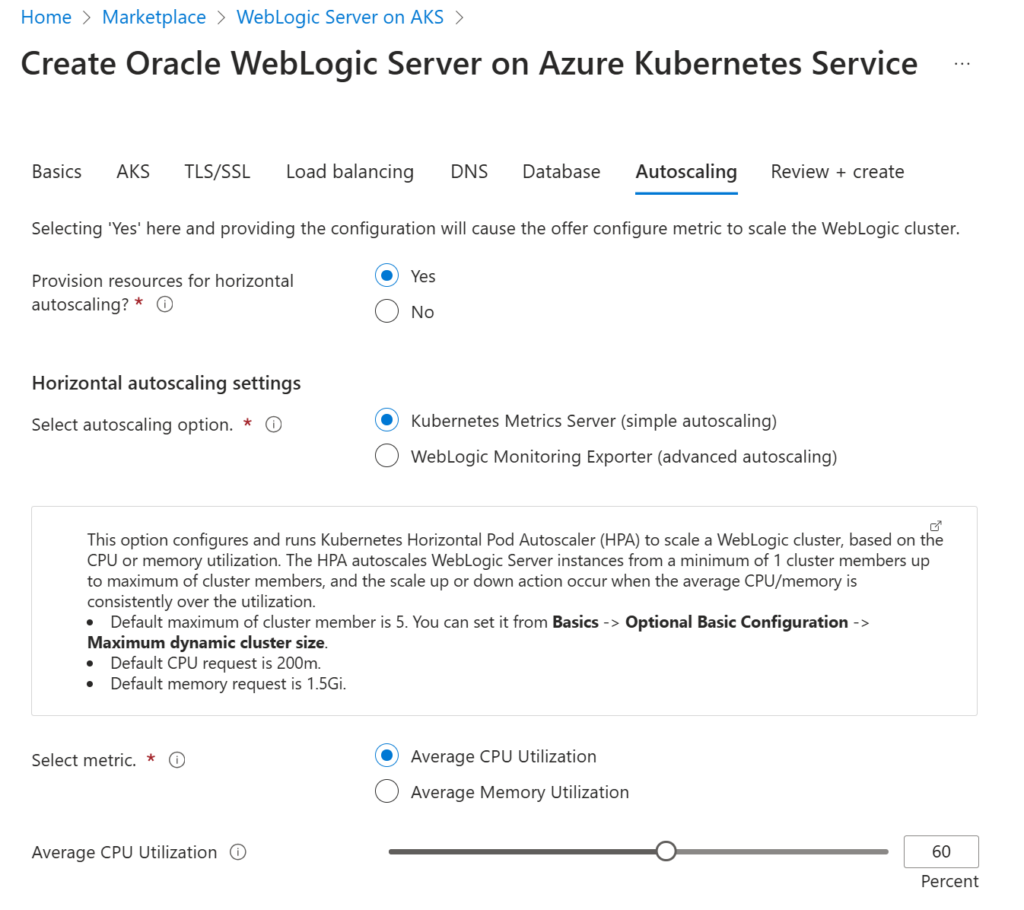Hi everyone, welcome to the June 2024 update for Jakarta EE on Azure. The June update covers the following topics:
- The newly published High Availability and Disaster Recovery tutorials, which demonstrate how to implement HA/DR for different Jakarta EE applications on Azure using a simple and effective method.
- The updated offerings that provide support for horizontally auto-scaling Jakarta EE server clusters on AKS and ARO.
Microsoft partners with Jakarta EE application server vendors to create Azure Marketplace offers. These Marketplace offers have Solution Templates and Base Images which allow customers to quickly deploy their software on Azure Virtual Machines (VMs), Azure Kubernetes Service (AKS), Azure Red Hat OpenShift. Additionally, within the Azure Learn platform, you’ll find an extensive collection of Java EE, Jakarta EE and MicroProfile documentation guidance. This documentation simplifies the process of deploying production-ready applications by incorporating best practices from both Jakarta EE application server vendors and Microsoft onto the Azure service of your choice. Furthermore, there are numerous supporting technologies for open specifications based Cloud Native Java, such as Quarkus extensions, the Azure MicroProfile library, and integrations with other Azure development services. To refresh your experience using Java EE, Jakarta EE, and MicroProfile on Azure, here is the news you should know!
If you’re interested in providing feedback or working closely on your migration scenarios with the engineering team developing WebSphere on Azure solutions, fill out this short survey on Jakarta EE migration and include your contact information. The team of program managers, architects, and engineers will promptly get in touch with you to initiate close collaboration.
Get High Availability and Disaster Recovery (HA/DR) for your Jakarta EE on Azure workloads
High Availability (HA) and Disaster Recovery (DR) are critical aspects of ensuring the reliability and continuity of Jakarta EE systems. HA refers to designing systems that minimize downtime and ensure continuous operation, while DR focuses on recovering from major incidents. The 4 tutorials recently published demonstrate simple and effective ways to implement HA/DR for different Jakarta EE applications on Azure. HA/DR is a complex topic, with many possible solutions and the best solution depends on your unique requirements. At the end of each article, you’ll find additional resources for exploring alternative approaches to implementing HA/DR.
![]() Tutorial: Migrate WebSphere Application Server to Azure Virtual Machines with high availability and disaster recovery – Java on Azure | Microsoft Learn
Tutorial: Migrate WebSphere Application Server to Azure Virtual Machines with high availability and disaster recovery – Java on Azure | Microsoft Learn
This tutorial demonstrates a straightforward and efficient approach to implement HA/DR for Java applications using WebSphere Application Server on Azure Virtual Machines (VMs). The solution illustrates how to achieve a low Recovery Time Objective (RTO) and Recovery Point Objective (RPO) using a simple database-driven Jakarta EE application running on WebSphere Application Server. You’re encouraged to connect with the development team and provide feedback on further improving WebSphere on Azure solutions.
The diagram below depicts the architecture built in the tutorial.
![]() Tutorial: Migrate WebSphere Liberty/Open Liberty to Azure Kubernetes Service with high availability and disaster recovery – Java on Azure | Microsoft Learn
Tutorial: Migrate WebSphere Liberty/Open Liberty to Azure Kubernetes Service with high availability and disaster recovery – Java on Azure | Microsoft Learn
This tutorial demonstrates a simple and effective way to implement high HA/DR for Java using WebSphere Liberty/Open Liberty on Azure Kubernetes Service (AKS). The solution illustrates how to achieve a low Recovery Time Objective (RTO) and Recovery Point Objective (RPO) using a simple database-driven Jakarta EE application running on WebSphere Liberty/Open Liberty. You’re encouraged to connect with the development team and provide feedback on further improving WebSphere on Azure solutions.
The diagram below depicts the architecture built in the tutorial.
![]() Tutorial: Migrate Oracle WebLogic Server to Azure Virtual Machines with high availability and disaster recovery – Java on Azure | Microsoft Learn
Tutorial: Migrate Oracle WebLogic Server to Azure Virtual Machines with high availability and disaster recovery – Java on Azure | Microsoft Learn
This tutorial demonstrates a straightforward and efficient approach to implement HA/DR for Java using Oracle WebLogic Server (WLS) on Azure Virtual Machines (VMs). The solution illustrates how to achieve a low Recovery Time Objective (RTO) and Recovery Point Objective (RPO) using a simple database driven Jakarta EE application running on WLS. You’re encouraged to connect with the development team and provide feedback on further improving WebLogic on Azure solutions.
In this tutorial, it provides step-by-step guidance for setting up an HA/DR solution consisting of an active-passive application infrastructure tier with an active-passive database tier, and in which both tiers span two geographically different sites. At the first site, both the application infrastructure tier and the database tier are active. At the second site, the secondary domain is shut down, and the secondary database is on standby.
![]() Tutorial: Migrate Oracle WebLogic Server to Azure Kubernetes Service with geo-redundancy – Java on Azure | Microsoft Learn
Tutorial: Migrate Oracle WebLogic Server to Azure Kubernetes Service with geo-redundancy – Java on Azure | Microsoft Learn
This tutorial demonstrates a straightforward and effective way to implement a business continuity and disaster recovery (DR) strategy for Java using Oracle WebLogic Server (WLS) on Azure Kubernetes Service (AKS). The solution illustrates how to back up and restore a WLS workload using a simple database-driven Jakarta EE application running on AKS. You’re encouraged to connect with the development team and provide feedback on further improving WebLogic on Azure solutions.
In this tutorial, It provides step-by-step guidance for setting up an HA/DR solution consisting of an active-passive application infrastructure tier with an active-passive database tier, and in which both tiers span two geographically different sites. At the first site, both the application infrastructure tier and the database tier are active. At the second site, the secondary domain is shut down, and the secondary database is on standby.
Configure Kubernetes Event-Driven Autoscaling (KEDA) on Prometheus for your WebLogic on AKS workloads
This tutorial shows you how to migrate Oracle WebLogic Server (WLS) to Azure Kubernetes Service (AKS) and configure automatic horizontal scaling based on Prometheus metrics:
![]() Tutorial: Migrate Oracle WebLogic Server to AKS with KEDA scaler based on Prometheus Metrics – Java on Azure | Microsoft Learn
Tutorial: Migrate Oracle WebLogic Server to AKS with KEDA scaler based on Prometheus Metrics – Java on Azure | Microsoft Learn
You are guided to integrate KEDA with your AKS cluster to scale the WLS cluster based on Prometheus metrics from the Azure Monitor workspace. KEDA monitors the Azure Monitor managed service for Prometheus and feeds that data to AKS and the Horizontal Pod Autoscaler (HPA) to drive rapid scaling of the WLS workload. You’re encouraged to connect with the development team and provide feedback on further improving WebLogic on AKS solutions.
The following diagram illustrates the architecture to build.
For more details on the features that power Horizontal Pod Autoscaling (HPA) or KEDA in the WebLogic on Azure offers, continue to read the following topic.
Get Horizontal Pod Autoscaling (HPA) or KEDA for your WebLogic on AKS workloads
Now the Azure Application offers of Oracle WebLogic on AKS have been refreshed to provide support for dynamic autoscaling. You must specify one of the two autoscaling options and autoscaling settings. The two options are
- Kubernetes Metrics Server (simple autoscaling): this option configures and runs Kubernetes Horizontal Pod Autoscaler (HPA) to scale a WebLogic cluster, based on the CPU or memory utilization.
- WebLogic Monitoring Exporter (advanced autoscaling): this option allows you to create Java metric aware KEDA scaling rules.
You’re encouraged to connect with the development team and provide feedback on WebLogic on AKS solutions. The diagram below is a screenshot of enabling auto-scaling when deploying the offer of Oracle WebLogic on AKS.
For more information, you may refer to this documentation.
Git Horizontal Pod Autoscaling (HPA) for your Liberty on AKS or Liberty on ARO workloads
Now the Azure Application offers of IBM Liberty on Azure Kubernetes Services (AKS) and IBM Liberty on Azure Red Hat OpenShift (ARO) have been refreshed to provide support for the existing dynamic scaling feature of the Open Liberty Operator. You’re encouraged to connect with the development team and provide feedback on further improving WebSphere on AKS solutions.
The diagram below is screenshots of the panel for enabling auto-scaling replicas when deploying IBM Liberty on AKS or ARO.
Take a glimpse of Jakarta EE on Azure offers
Microsoft partners with IBM, Oracle, and Red Hat to bring their app server products to Azure:
- To explore IBM WebSphere Product Family on Azure, start from the Learn topic – What are solutions to run the WebSphere family of products on Azure?
- To explore Oracle WebLogic Server on Azure Solutions, start from the following Learn topics
- To explore JBoss EAP on Azure, start from the Learn topic – Red Hat JBoss EAP on Azure
We also have multiple supporting technologies for Cloud Native Java, which include but are not limited to the Quarkus extensions, the Azure MicroProfile library, and integrations into other Azure developer services.
Quarkus Azure Services Extensions are:
- Quarkus Azure App Configuration Extension: pkg:maven/io.quarkiverse.azureservices/quarkus-azure-app-configuration@1.0.4 | code | doc | sample
- Quarkus Azure Blob Storage Extension: pkg:maven/io.quarkiverse.azureservices/quarkus-azure-storage-blob@1.0.4 | code | doc | sample
- Quarkus Azure key Vault Extension pkg:maven/io.quarkiverse.azureservices/quarkus-azure-keyvault@1.0.4 | code | doc | sample
Azure Extensions for MicroProfile are:








0 comments